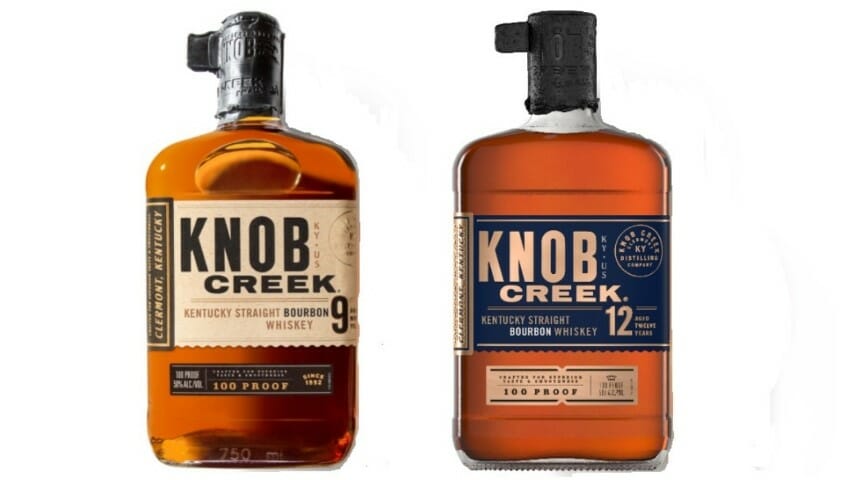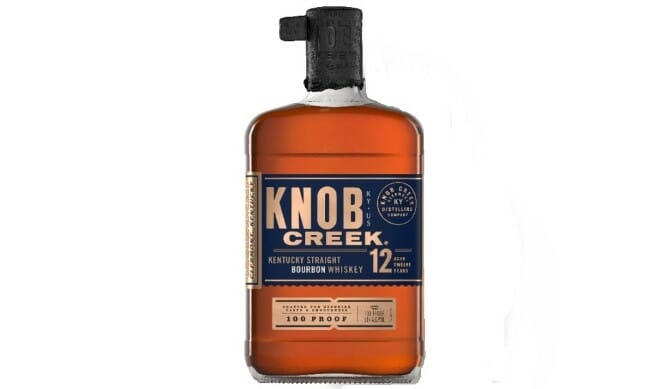Bourbons Revisited: Knob Creek 9 and Knob Creek 12 Year Old
Photos via Knob Creek, Jim Beam
When the demand for bourbon causes even the likes of Jim Beam to reassess and alter the age statements of some of their core products, you know it’s been a busy decade for whiskey. Simply put, the major distilleries of the early and mid 2000s had no idea what a boom period the 2010s would turn out to be. The surge of interest in brown liquor, and especially in American bourbon and rye, took historic giants like Beam by surprise, causing shortages of various genre stalwarts that were once seen as bottom-shelf “grandpa liquor” by Millennial consumers who suddenly couldn’t get enough of the stuff. The effects of that surge in demand caused ripple effects that spread across the industry.
One of the most prominent of those effects was the loss of age statements from many famous brands, and the introduction of many new non-age-stated (NAS) whiskeys, especially from craft distilleries. Some of those age statements, like the 12-year one that once adorned bottles of Heaven Hill’s Elijah Craig, left and never returned. Others, like the 9-year age statement on Beam’s Knob Creek, have demonstrated the opposite desire—disappearing for a time, but now returning in a blaze of glory.
Knob Creek is a brand you’ve surely seen on the package store shelves or bar backs over the years—it’s ubiquitous and readily available everywhere. It was one of the original bourbons to label itself as “small batch,” a nebulous term that implies small selections of barrels (usually between 10-100) are married together in each batch for consistency. This makes for slightly more variation than truly huge products like Jim Beam White Label, but enough consistency that each batch tastes very similar. They make a good tandem with single barrel releases, which you’ll also see in the Knob Creek line—where each single barrel is wildly different, you know what you’re getting with the small batch.
The flagship Knob Creek product, known in recent years as simply Knob Creek Small Batch, lost its 9-year age statement in 2016 when the distillery’s stock of whiskey couldn’t keep up with increasing demand. It would seem that their expansion of aging capacity in the meantime has paid off, however, as 2020 sees the return of the 9-year age statement once again, complete with a new label and look for the brand. This is a moment in time when a lot of drinkers will likely be re-assessing Knob Creek and looking at it as a new brand, so we’re going to do the same.
At the same time, Knob Creek is going one step further by flexing their access to well-aged stocks with the debut of a new year-round product, Knob Creek 12 Year Old Bourbon. Like the flagship 9 year old, it weighs in at an ample but approachable 100 proof, although it carries a significantly higher MSRP. I sat down to taste both and see how these classics from Beam have been holding up.
Knob Creek 9 Year Old Bourbon Whiskey
MSRP: $35

Knob Creek has long been one of those easy to find, solid middle shelf values of the bourbon world, and the return of the 9-year age statement gives it a bit more cred in a market where so many of these classic bourbons are now lacking them. At prices that typically fluctuate between $30-35, it’s a good value no matter what price point you find it at, especially considering that it’s a full 100 proof. Comparable products, like Old Forester Signature, are likely to lack an age statement, or be considerably more expensive if they do carry one. Such are the benefits of bulk production, when you’re Jim Beam.
I’ll be honest when I say that I often don’t really care for the profile of younger Beam bourbons, whether that’s value brands like Old Crow or most of the core Jim Beam lineup. To my palate, they have a tendency to be dominated by a certain, nutty peanut note and sawdust-like wood profile, which for a while made me think that I simply didn’t appreciate the Beam house style. Eventually, I came to learn that it’s not that I don’t like Beam—I just feel like their bourbon needs significantly more age on it than some other distilleries before it rounds into form. That’s just one of the reasons I was happy to see this age statement return.
